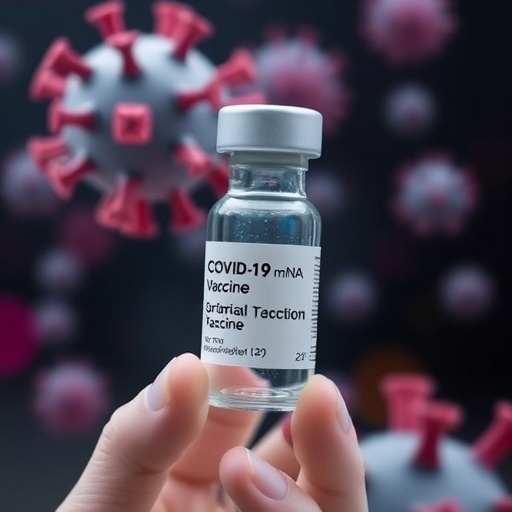
In a groundbreaking study published in BMC Cancer, researchers have unveiled a compelling U-shaped relationship between serum lactate dehydrogenase (LDH) levels and all-cause mortality in cancer patients. This extensive retrospective cohort study, which evaluated data spanning nearly two decades, offers crucial insights into how fluctuations in LDH—the critical metabolic enzyme involved in anaerobic glycolysis—correlate with survival outcomes across a broad spectrum of cancer diagnoses.
LDH, a well-known intracellular enzyme, plays an essential role in converting lactate to pyruvate, a pivotal step in cellular energy metabolism especially under hypoxic conditions. Elevated LDH levels have long been recognized as a marker of tumor burden, tissue breakdown, and prognosis in several malignancies. However, the precise nature of its association with mortality among diverse cancer cohorts had remained elusive until now.
The study analyzed clinical data from 4,337 cancer patients derived from the National Health and Nutrition Examination Survey (NHANES) conducted between 1999 and 2018. This large, representative sample allowed for a robust examination of serum LDH’s prognostic value while accounting for multiple confounders such as demographic factors, anthropometry, metabolic indicators, and comorbidities. The primary outcome tracked was all-cause mortality over a total of 39,217.58 person-years of follow-up.
.adsslot_eb2XPWHvB5{width:728px !important;height:90px !important;}
@media(max-width:1199px){ .adsslot_eb2XPWHvB5{width:468px !important;height:60px !important;}
}
@media(max-width:767px){ .adsslot_eb2XPWHvB5{width:320px !important;height:50px !important;}
}
ADVERTISEMENT
Sophisticated multivariable Cox proportional hazard models revealed that each incremental increase of 10 U/L in serum LDH correlated with a 5.0% heightened risk of mortality after adjustment for other variables. More strikingly, the relationship between LDH levels and mortality risk was nonlinear, exhibiting a distinct U-shaped curve rather than a simple linear trend. This nuance suggests that both abnormally low and high LDH levels predispose cancer patients to increased risk of death.
Delving deeper, the researchers identified a critical inflection point at 128 U/L of LDH. Below this threshold, mortality risk surprisingly decreased by approximately 7% with rising LDH values, indicating a protective or compensatory role of LDH at moderately low levels. Beyond 128 U/L, however, mortality risk surged by 8% per 10 U/L increase, consistent with the enzyme’s known association with extensive tumor activity, hypoxia, and systemic inflammation.
Sex-specific analyses provided additional layers of insight. While the U-shaped pattern persisted in both males and females, the optimal LDH thresholds diverged; the protective inflection point was lower in males at 121 U/L, whereas females showed a higher threshold of 136 U/L. These findings suggest potential biological and hormonal influences modifying the enzyme’s prognostic significance across genders.
The researchers employed rigorous statistical methodologies, including generalized additive models utilizing penalized splines and two-piecewise Cox regression models, to capture the complex nonlinear dynamics in the data accurately. By leveraging advanced modeling techniques, the team ensured that subtle but clinically relevant inflection points were precisely estimated rather than neglected in traditional linear analyses.
This study’s revelations have immediate clinical ramifications. Monitoring serum LDH levels in cancer patients may provide a more refined prognostic tool than previously appreciated—not merely signaling poor outcomes at elevated levels but also highlighting risks associated with unusually low levels. This could reshape how clinicians interpret LDH assays within oncology workflows and refine patient stratification for tailored treatment strategies.
The biological underpinnings of the U-shaped association are intriguing and deserve further exploration. While elevated LDH is well-understood as a surrogate for tumor hypoxia, aggressive disease, and systemic catabolism, the hazards linked to abnormally low LDH remain less defined. Hypothetically, excessively low LDH levels might reflect compromised metabolic reserves or impaired cellular adaptation to stress, which could predispose patients to vulnerability during cancer progression or treatment.
Future investigations could delve into mechanistic studies to elucidate LDH’s dualistic role and explore whether therapeutic modulation of LDH activity might influence survival outcomes. Moreover, sex-based differences in metabolism and endocrine regulation may partially account for the discrepant optimal LDH thresholds, warranting exploration of gender-specific treatment paradigms.
Given the extensive person-years of follow-up and thorough covariate adjustments, this study stands among the most comprehensive evaluations of serum LDH’s prognostic relevance in oncology to date. Furthermore, integrating data from NHANES bolsters the generalizability of the findings across diverse populations and cancer types, underscoring the enzyme’s universal importance.
In summary, this landmark research expands our understanding of lactate dehydrogenase as more than a mere biomarker of cancer severity. It emerges as a nuanced prognostic indicator exhibiting a U-shaped association with mortality risk, thereby challenging the prevailing dogma that “lower LDH is always better.” For clinicians and researchers, these insights pave the way for novel risk stratification approaches and potentially innovative metabolic interventions tailored to maintain LDH within optimal ranges.
As oncology continues to embrace precision medicine, biomarkers like LDH that integrate metabolic, inflammatory, and proliferative signals into patient risk profiles will become increasingly vital. This study not only adds a critical piece to the puzzle connecting tumor metabolism with clinical outcomes but also highlights the importance of considering nonlinear biomarker relationships to avoid oversimplified interpretations.
Ultimately, these findings call for vigilant LDH monitoring throughout cancer care pathways. Maintaining LDH concentrations within identified thresholds could emerge as a therapeutic target or indicator of treatment efficacy. As further studies validate and expand these observations, integrating LDH dynamics into prognostic models could transform how oncologists predict survival and tailor interventions, ultimately enhancing patient care and outcomes.
The clarity offered by this research on the dualistic impact of serum LDH levels marks a significant advance in cancer biomarker science. By highlighting a precise inflection point and sex-specific thresholds, it challenges researchers and clinicians alike to rethink longstanding assumptions about tumor metabolism and patient prognosis.
In conclusion, serum LDH proves to be a critical enzyme with complex prognostic implications in cancer patients, exhibiting a U-shaped association with all-cause mortality and distinct optimal ranges differentiated by sex. These novel insights derived from a comprehensive, nationally representative cohort underscore the enzyme’s multifaceted role in cancer biology and survival. As such, LDH measurement should be integrated thoughtfully into oncologic assessment and management paradigms moving forward.
Subject of Research: The association between serum lactate dehydrogenase (LDH) levels and all-cause mortality risk in cancer patients.
Article Title: U-shaped association of serum lactate dehydrogenase with all-cause mortality in cancer patients: a retrospective cohort study.
Article References:
Zhang, M., Guo, R., Xi, X. et al. U-shaped association of serum lactate dehydrogenase with all-cause mortality in cancer patients: a retrospective cohort study. BMC Cancer 25, 1143 (2025). https://doi.org/10.1186/s12885-025-14567-1
Image Credits: Scienmag.com
DOI: https://doi.org/10.1186/s12885-025-14567-1
Tags: cancer diagnoses and LDH correlationcomorbidities affecting cancer survival ratesdemographic factors in cancer mortality studiesfluctuations in LDH and survival outcomesimpact of LDH on all-cause mortalitymetabolic enzymes in cancer prognosismultNHANES data analysis in cancer researchretrospective cohort study on cancer patient survivalrole of LDH in anaerobic glycolysisserum lactate dehydrogenase as a cancer prognostic markerU-shaped relationship between LDH levels and cancer mortality





